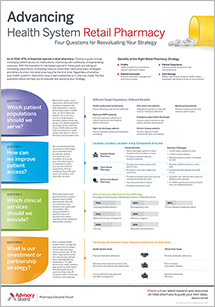Auto logout in seconds.
Continue Logout
By Lindsay Conway, Managing Director, Pharmacy Executive Forum
Amazon's movement into health care has sparked panic from leaders across the industry, from those working in health systems to those in the supply chain. But in most health care areas, Amazon's plans are somewhat speculative and still forming. Pharmacy is different. Amazon's acquisition of direct-to-consumer pharmacy start-up PillPack has solidly placed them within the pharmacy sphere—and recently released court documents show that they have big plans for disruption.
Two weeks ago, we held a webconference on Amazon's health care strategy and received dozens of great questions from members. As we've been responding to them, we wanted to share some of our answers about Amazon's entry into pharmacy. Read on for our responses, and stay tuned for more answers to your top Amazon questions.
Get the slides: What 'Amazon health care' could look like in 5 years
1. Is Amazon's entry into the pharmacy business good or bad for health systems?
About 80% of health systems operate some sort of retail pharmacy, and PillPack is a direct competitor for that business. However, the margins on retail prescriptions tend to be small, so losing them to PillPack wouldn't be a big financial blow.
But finances alone don't tell the whole story, so it's worth examining the bigger picture. PillPack is building relationships with a strategically important patient population—complex and chronic disease patients—who generate an average of $5,000 per year for the company in insurance payments and out-of-pocket spending. Most of these patients have more interactions with their pharmacy than with their providers. So if health systems lose these patients' pharmacy business to retail pharmacies, they're also losing important opportunities to provide care management. Moreover, managing the medications of these patients is critical to succeeding under population health models. If health systems lose the ability to manage these patients, they may lose a critical lever in preventing future expensive ED and inpatient visits.
2. There's been a lot of buzz about PillPack. Is that just because they were acquired by Amazon? Or do they actually offer meaningfully different services from other pharmacies?
PillPack's services are designed to make it easier for all patients (and polypharmacy patients in particular) to take their prescription medications. To that end, they handle coordination with the patients' providers and payers; offer services such as free shipping; and create customized packets of medications for each patient, sorted by the date and time recipients are supposed to take them. These services are especially valuable for patients who are taking many medications, or medications with variable schedules and dosing instructions.
While undoubtedly useful, any of these services can be replicated. And the most notable, custom packaging for individual patients, already has been replicated by a number of health system-owned pharmacies and pharmacy chains (including major competitors like CVS).
Their other main draw, coordinating with providers, is also touted by lots of pharmacies. However, many of these efforts fall short. In particular, with a mail-order pharmacy, there's always a danger that the patient's medication or dosage will change just after the order has been processed. As a result, patients may wind up paying for two weeks' worth of medication that they can't use. Or worse, if the medications are pre-packaged, then there's a risk patients will take them incorrectly.
PillPack's leaders have shown that they understand the challenges patients face in managing complex medication, and that they are committed to helping them overcome these barriers. However, the company (and Amazon, by extension) is grappling with the same barriers as every other pharmacy, and I haven't seen any evidence that PillPack is, or will be, more successful.
3. How does PillPack fit into Amazon's larger strategy?
To date, Amazon has announced or hinted at three goals for PillPack:
1. Expand the pharmacy's services to Amazon's employees in hopes of realizing cost savings—just like health systems do for their own employees and beneficiaries;
2. Grow PillPack's revenues. Amazon obviously has a much larger customer base than PillPack, but the average PillPack customer generates almost four times more revenue than the average Prime customer. So there's a significant opportunity to cross-sell PillPack's services to Prime members and vice versa. And, moreover, Amazon can use data from these customers' past buying habits to target marketing for other products; and
3. Explore potential business partnerships with payers, employers, or perhaps Haven. We know that Blue Cross Blue Shield has spoken with PillPack about exploring potential collaboration, and presumably there are others who would be interested in their services, especially if they have a large population of polypharmacy and chronic disease patients. CVS' lawsuit against PillPack (over a former executive's plan to join the company) indicates that PillPack sees these direct contracts with health plans and employers as a key component of their strategy.
4. How will Amazon expand on PillPack's existing capabilities?
Amazon hasn't made any announcements about how they are hoping to expand PillPack, but we can speculate about where they might invest, given their core competencies and the size of the opportunity.
An obvious starting point is to extend Amazon's warehousing and shipping capabilities to PillPack's operation to shorten delivery times and increase efficiencies. Additionally, Amazon has a growing physical footprint, consisting of Whole Foods stores, Amazon grocery and bookstores, as well as Amazon lockers. These physical locations could also become pick-up sites for pharmacy customers, especially in urban areas.
Amazon could also push PillPack into more innovative areas. At its heart, Amazon is a technology company, and digi-ceuticals are a rapidly growing area. Amazon could potentially extend its tech capabilities to develop tools to help patients manage and improve their health, for example, diagnostics and technologies that increase medication adherence.
They could also push greater price transparency. For many patients, price is a big barrier to taking medications. You can imagine Amazon using its online market place to give patients and their prescribers information about price and out-of-pocket costs at the point of care.
Finally, all of these activities generate a lot of data, which is highly valued by pharmaceutical companies, payers, and providers. Amazon could potentially commercialize the data it collects on medication use and patient-reported outcomes.
5. How should health systems respond?
Not every health system-owned pharmacy can or should try to compete with PillPack. Those who do try to compete should think carefully about how they will meet or exceed PillPack's capabilities when it comes to access, service, and cost—Amazon's core competencies.
Those who don't may want to consider a partnership to ensure coordination and data sharing where appropriate. PillPack hasn't announced any provider partnerships, but you could imagine a number of mutually beneficial scenarios. Partnership could potentially improve PillPack's ability to coordinate with prescribers, and it would help prescribers ensure that their patients have timely access to critical medications, potentially reducing avoidable hospitalizations and emergency room visits.
To learn more about to create a principled pharmacy business strategy, download our new report on Realizing Pharmacy's Full Value.
Don't miss out on the latest Advisory Board insights
Create your free account to access 1 resource, including the latest research and webinars.
Want access without creating an account?
You have 1 free members-only resource remaining this month.
1 free members-only resources remaining
1 free members-only resources remaining
You've reached your limit of free insights
Become a member to access all of Advisory Board's resources, events, and experts
Never miss out on the latest innovative health care content tailored to you.
Benefits include:
You've reached your limit of free insights
Become a member to access all of Advisory Board's resources, events, and experts
Never miss out on the latest innovative health care content tailored to you.
Benefits include:
This content is available through your Curated Research partnership with Advisory Board. Click on ‘view this resource’ to read the full piece
Email ask@advisory.com to learn more
Click on ‘Become a Member’ to learn about the benefits of a Full-Access partnership with Advisory Board
Never miss out on the latest innovative health care content tailored to you.
Benefits Include:
This is for members only. Learn more.
Click on ‘Become a Member’ to learn about the benefits of a Full-Access partnership with Advisory Board
Never miss out on the latest innovative health care content tailored to you.

